Tribal marks: Meanings, types, history in Nigeria
Tribal marks are bodily marks by which people are identified. Blades and knives are used to pierce the skin to form permanent scars. It is a common practice in Africa, especially in Nigeria and Ghana. Ethiopia, Sudan and Tanzania are also countries where the practice is popular.
Table of Content hide 1 Tribal marks and their meaning 1.1 1. Identification 1.2 2. Beautification 1.3 3. Spiritual protection 1.4 4. Healing 2 Types of tribal marks 2.1 Dinka 2.2 Gar 2.3 Woodabe 2.4 Kosanma/Donko 2.5 Datoga 3 Tribal marks in Nigeria 4 History of tribal marks in Nigeria 5 Yoruba tribal marks 5.1 1. Pele 5.2 2. Owu 5.3 3. Keke 5.4 4. Abaja 5.5 5. Nupe 6 Hausa tribal marksTribal marks and their meaning
People draw lines on their bodies for various purposes. Let’s take a look at the four major meanings:
1. Identification
In Yorubaland, tribal marks are a means to identify a newborn as part of a family. Every family or clan has its own distinctive marks to identify themselves wherever they are.
2. Beautification
These lines serve as a means of beautification as some men and women believe it makes them look more attractive.
3. Spiritual protection
In some parts, the marks are believed to grant special powers to the bearer. Tribal marks are believed to protect a child from evil powers and death from a young age.
4. Healing
Tribal marks also serve medicinal healing to the bearer. In some places, healers mark children to recover convulsion, pneumonia and measles. Faces, stomach or other parts of the affected body are where the marks are made.
ALSO READ: Top banks in Nigeria
Types of tribal marks
This is deeply rooted in African culture. As scary as some of these marks look, there is a story behind them. Below are five common types of tribal marks and where they are located.
Dinka

The people of Dinka are a unique tribe that dwells on the East and West banks of the River Nile, Sudan. Their marks are characterized by various carved lines on the forehead on each side to form a ‘V’ shape. Males mark themselves that way to signify the transition to manhood. Any boy who cries in the process is not regarded as a man.
Gar

Gar marks are done by the Nuer people in southwestern Ethiopia and Sudan. A strip of six parallel horizontal lines is drawn across the forehead. For the women, patterns are dotted across their skins.
Woodabe

Woodabe people are a sub-ethnic Fulani tribe. Their marks are made from henna, a natural dye that leaves black marks on the skin. The people believe these marks ward off evil spirits. However, beautification is the main reason why they mark themselves.
Kosanma/Donko

Kosanma or Donko originated from Ghana. Donko marks are engraved on the faces of a “reincarnated child” or what the Yoruba and Igbo call “abiku” and “ogbanje” respectively. These marks are believed to take away the potentially dangerous powers of the child and identify him or when during birth. Kosanma or Donko marks are also believed to ward off evil spirits torturing a family or group. Ghana’s Minister of Employment, E A Mensah has this mark as seen in the photo.
Datoga
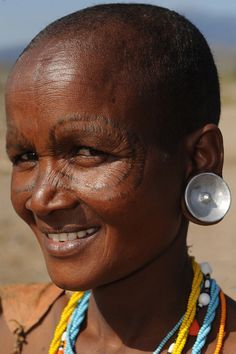
The Datoga tribe are cattle herders from Tanzania. Their body modification technique is to make small cuts on the face and allow them heal to form an aesthetic pattern. Moreover, Datoga mothers use tribal marks as a kind of talisman to protect their children from evil and remove tic substances from the body. They strongly believe in the magical powers of these marks.
ALSO READ: Natural resources in Nigeria and where to find them
Tribal marks in Nigeria
Nigeria is a country that is deeply rooted in culture. Tribal marks are part of the people’s culture especially the Yoruba, Hausa and Edo. Igbo of the southeastern region are not particularly known for tribal marks. However, some parts use marks like ichi, nsibidi, egbugbu, uli, nki and ogbanje. These marks mostly serve spiritual and health purposes.
Furthermore, Edo people call tribal marks iwu. So if you’re wondering why Edo people, who are basically known for upholding their culture and tradition, rarely have tribal marks on their faces, know that they prefer marking themselves on their stomachs, sides and backs.
Ude is another popular tribal mark in Edo State. Just as in other tribes, ude is an ancient tradition performed on children who suffer from strange illnesses from infancy. It is believed that ude will stop the illnesses and ward off future evil attacks. Tiny incisions are made on the stomach, back and face.
However, science has since shown that the so-called strange illnesses that these children suffer are likely sickle cell anaemia. But it hasn’t stopped the tradition from being practised to this day.
For the Urhobo of the South-South, tribal marks are moderately common in Udu, Ughievwen, Uvwie, Agbarha (Warri) and the Okere (Urhobo) Warri. The people of these areas draw three tiny marks below their eyes. Irhiawoho also known as Chicken Claws is another popular tribal mark among the Urhobo where marks are made at the corners of the eyes towards the ears. Another mark is Akpurusi which is popular among the Urhobos of Orogun, Evwreni, Eghwu, Uwheru and others. Akpurusi is one bold straight line incised on the forehead.
Urhobo women prefer marking themselves on the neck, cheeks, arms, stomach and around the navel.
History of tribal marks in Nigeria
Tribal marks history in Nigeria can be officially traced to the 14th century, during the trans-Atlantic slavery era. At the time, people used tribal marks to identify themselves after they escaped from captivity. Tribal marks helped people retain their roots and culture when they were captured and taken into slavery.
Today, it is no longer a common practice in Nigeria. It is now regarded as archaic, unhealthy and pagan. In 2017, a bill was passed to stop tribal marks. Even some towns and villages listed punishments for offenders. But the practice has not completely faded yet.
Yoruba tribal marks
Most tribal marks in Nigeria are traced to the Yoruba people of the southwestern region. The Yoruba society is a highly patriarchal one. Therefore tribal marks called Ila are given to every child born into a family to mark their full kindred membership rights. In some parts of Oyo State, tribal marks are given to firstborn children to mark their legitimacy in special cases. Here are the top five tribal marks in Yorubaland:
ALSO READ: Richest musicians in Nigeria 2022
1. Pele

Pele originated from Ile-Ife in Osun State. But almost all parts of Yoruba have their own form of Pele. To create the mark, three long lines are inscribed on both cheeks.
2. Owu
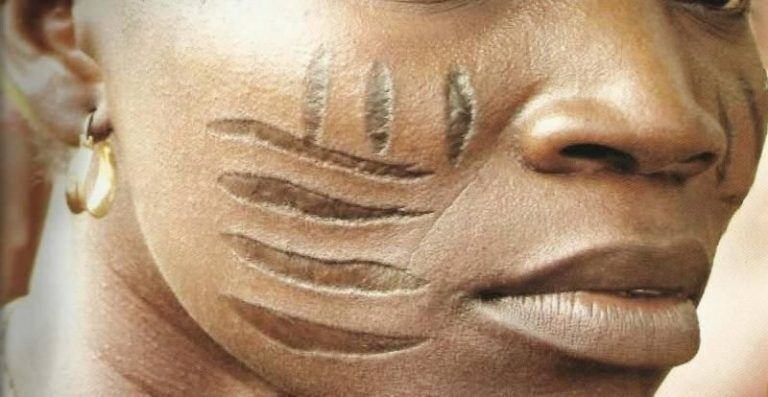
The people of Owu, Abeokuta, Ogun State, own this mark. It is comprised of six lines on each side of the face. Former Nigerian President Olusegun Obasanjo has this tribal mark.
3. Keke
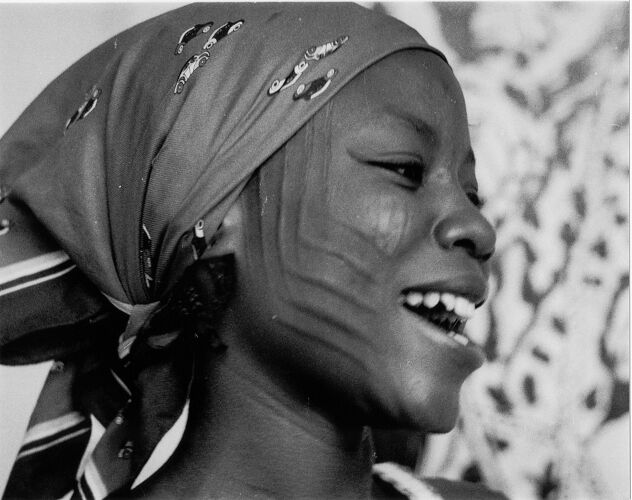
Also called Gombo, Keke is practised by the Ogbomoso people of Oyo State. Keke consists of curved lines on both sides of the cheek.
4. Abaja
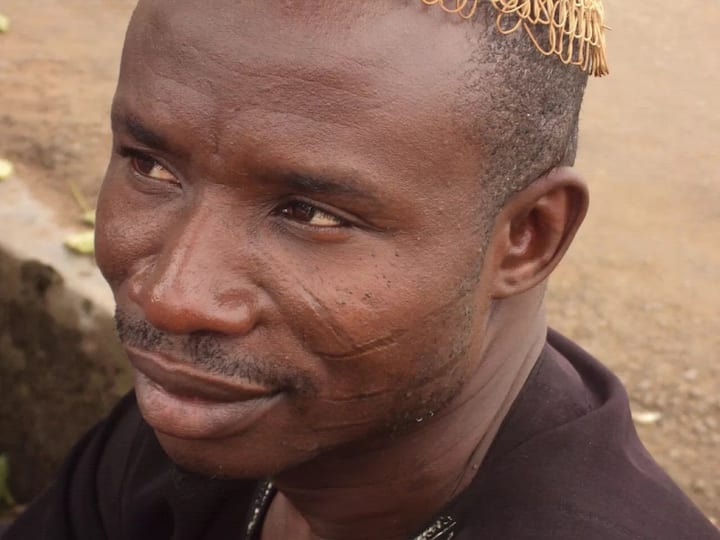
Abaja is a unique tribal mark that originated in Oyo State. Three or four horizontal lines are made on the cheek. Oba Lamidi Adeyemi III has this mark.
5. Nupe
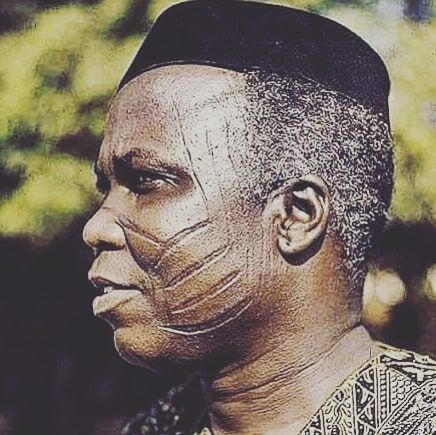
Nupe people are mostly located in some parts of Kwara and Kogi States. Their marks are drawn with different styles of curves on the face.
Hausa tribal marks
Tribal marks are an integral part of Hausa culture. The Hausas named their marks zube, yan baka, doddori, bille, kalangu etc. Among the Hausa-Fulani, there is fula tribal marks. At first, Fula marks were purely for identification. The marks are made to make it easy for kith and kin to identify themselves in the event of invasion, war or getting lost and captured for slavery. Later, fula became a symbol of beauty, especially among women.
In conclusion, tribal marks are fast fading in Nigeria and other countries. Most of it has to do with the fact that it has affected the self-esteem of bearers. What was once regarded as a powerful tool for beautification and spiritual empowerment is not an object of ridicule in our society today. But do you blame us? Nope because the health risks associated with the practice, especially in transmitting viral diseases, are very high.
ALSO READ: NIN registration: How to link MTN, Glo, Airtel, 9mobile numbers
ncG1vNJzZmivp6x7tLfAm5isoF6YvK5706ugm5mcYrqivsqsZKKmXaO2qLHRopho